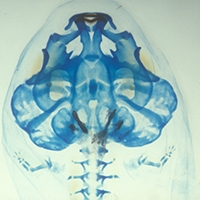Citation:
| 401 KB |
Date Published:
AugAbstract:
Direct development has evolved in rhacophorine frogs independently from other anuran lineages, thereby offering an opportunity to assess features associated with this derived life history. Using a developmental series of the direct-developing Philautus silus (Ranidae: Rhaeophorinae) from Sri Lanka, we examine features of cranial morphology that are part of a suite of adaptations that facilitate feeding in free-living tadpoles, but have been changed or lost in other direct-developing lineages. Larval-specific upper jaw cartilages, which are absent from many non-rhacophorine direct-developing species (such as Eleutherodactylus coqui), develop in embryos of P. silus. Similarly, lower jaw cartilages initially assume a larval morphology, which is subsequently remodeled into the adult jaw configuration before hatching. However, the cartilaginous jaw suspension and hyobranchial skeleton never assume a typical larval morphology. The palatoquadrate, which suspends the lower jaw, lacks the posterior connections to the braincase found in many metamorphosing species. Unlike in metamorphosing species, bone formation in P. silus begins before hatching. However, the sequence of bone formation resembles that of metamorphosing anurans more than that of other direct developers. In particular, P. silus does not exhibit precocious ossification of the lower jaw, which is characteristic of some frogs and caecilians that lack a free-living tadpole. These data reveal some similarities between Philautus and other direct-developing anurans. However, the departure of Philautus embryos from the generalized tadpole skeletal morphology is less pronounced than that observed in other direct-developing taxa.
Notes:
198LUTimes Cited:15Cited References Count:54






